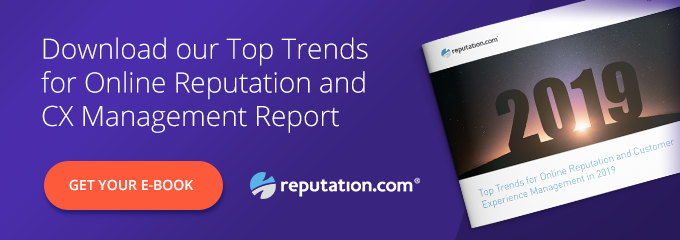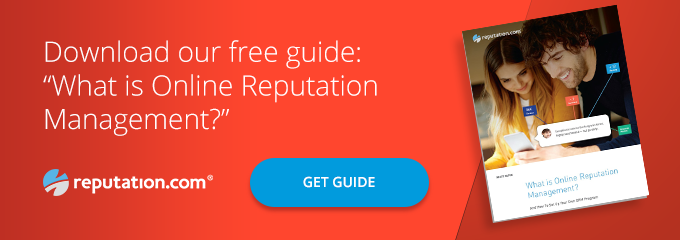The Value Gap – And the Dangers of Getting Too Comfortable
Reputation Staff Writer

This post originally appeared on LinkedIn. Click here to follow Reputation.com on LinkedIn.
When it comes to delivering a great customer experience, have you become a bit too comfortable? If it’s broke, don’t fix it? No news is good news?
Businesses tend to react to bad reviews and ratings, rather than being proactive about investigating what customers are saying about their experiences — until they start to notice something’s wrong. It’s normal — in fact, it’s human nature — but it’s not necessarily the right thing to do.
Let me illustrate how getting comfortable with “good enough” can create what I call a value gap.

Comfortable Isn’t Always Correct
It was the middle of summer in North Carolina. I took my 10-year-old daughter to a fastpitch softball camp at a neighborhood park to learn how to be a better hitter from a local legendary Coach, Monte Sherrill — an 8-time state championship winner and national coach of the year. He brought his high school players with him — to make a point.
First, Coach talked about how humans get comfortable doing things by routine. We wake up, have coffee and read the news. We get in the car and turn on the same radio station every day. We go to work and come home and watch TV. It was a simple, relatable concept, but I didn’t know where he was going with it.
Then he asked my daughter’s team to demonstrate their talent. They hit ball after ball in all directions all over the field. They were pretty good, that was clear — and you could tell they thought so. After they finished, Coach said: “Comfortable does not equal correct.”
What happened next changed everything. Coach Sherrill started shouting orders to his high school players in quick succession:
“Stance!” His high school players hit it — toes turned slightly inward, knees slightly bent, weight perfectly balanced and centered beneath each big toe.
“Toe-touch!” Each athlete lifted her front foot and gave the ground a delicate touch with their front foot toe.
“Heel plant!” Every heel came down.
“Jab!” Each player cranked her hips and with a jabbing motion, pointed the bat knob directly at where the ball would be at the release point from the pitcher’s glove.
He shouted several additional commands — and his players responded like soldiers. Then they lined up on the field and sent ball after ball sailing over the fence. The jaws of our twenty 10 year-olds fell open, and you could hear a pin drop. They had grown quite comfortable in their practice routines, but unlike the high schoolers, they didn’t have a system in place for maximizing their potential.
Without a System, Mediocre Becomes Routine
As consumers, we tend to fall into the same trap. Typically, this happens right before and throughout the “consumption” phase of the new customer journey— you buy something for a specific set of features, and after the newness of a purchase wears off, we go back into our old routine habits.
I remember when I bought my last car, I was fascinated with all the gadgets and bells and whistles. I drove it off the lot, took it home and fell right back into my comfortable habits. To this day, I still don’t know how to change the time on the clock or use the wipers on my headlights. I’m paying for these features, but not using them. That’s a glaring example of the value gap. The dealership lacked an effective system for educating me — and other buyers — about how to use the car’s features.
Why does this matter? Because any time a value gap exists, you leave room for a competitor to come in and tell a better story — one that moves people from comfortable to correct — and lure customers away.
The Ultimate CX Value Gap: Data in the Wild
Just like a softball player’s untapped potential, or a vehicle’s idle features, data that goes unmined puts you at a disadvantage. Businesses today have access to all kinds of data that’s created throughout the customer journey, but they’re not able to collect, analyze and use that data effectively. That’s a huge value gap — one that impacts your ability to deliver exceptional customer service.
In my last post, I talked about the difference between structured data and “data in the wild,” and how customer data isn’t just in your CRM. In fact, it’s everywhere — in online reviews, social posts and survey responses. And unless you have systems in place to capture all the data and analyze it collectively, you can’t get a 360-degree view of customer experience. Therein lies the value gap — and here are the consequences:
- Customer sentiment goes uncaptured.
- Customer-driven change stagnates.
- CSAT/NPS scores do not align with business trends.
- Revenues and profits decrease.
Even if your company is forward-thinking, and you’ve invested in capturing data in the wild and proactively managing your online reputation, have you considered:
- What department is gathering that data?
- What are you doing with all of that data?
- How do you communicate it to other departments to take action?
- Who do you hold other departments accountable?
- How do you close the loop?
- How do you account for it in your CSAT/NPS/loyalty/retention program?
- How do you compare location to location? Manager to manager? Region to region?
- How do you compare all of that to your competition’s locations?
- How do you compare the data to your competitors’ data, at a national and brand level?
The reality is, if you aren’t applying a systemic methodology and platform to take you to where you need to be, you’re wasting your time and resources — and causing your business to suffer from lost customer loyalty and advocacy.
Close the Value Gap with a Systematic Approach to Harnessing Data in the Wild
After that day on the baseball field, my daughter jogged to the car — the one with the clock still an hour off — covered in sweat, Carolina-red clay and mosquito bites. She smiled and drank her water, and we listened and sang Hannah Montana songs really loud. She went on to be a better hitter and have her best season ever, because now she had a system for realizing more of her potential. Now, whenever she starts getting comfortable, she remembers to hit her “stance” and look for ways to realize more of her potential.
This lesson can easily be applied to improving customer experience in your organization. You can’t just stay comfortable and rely on your old routines. You have put a systematic methodology in place to mine the vast amounts of unstructured data for true insight — and act on it.
If you want to solve your structured and unstructured data value gap, take a look at what Reputation.com has to offer. Download our free guide: “What is Online Reputation Management?” to get started.


